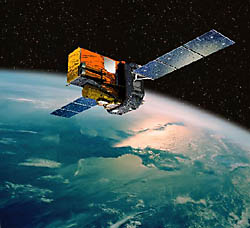The INTErnational Gamma-Ray Astrophysics Laboratory
INTEGRAL,
was launched in October 2002 aboard a Russian Proton rocket, and is
providing a new insight into the most violent and exotic objects of the
Universe, such as neutron stars, active galactic nuclei and
supernovae. INTEGRAL is also helping us to understand processes such as
the formation of new chemical elements and the mysterious gamma-ray
bursts, the most energetic phenomena in the Universe. Environments of
extreme temperature and density, near the event-horizons of black holes,
are a major topic of study with INTEGRAL.
These studies are possible thanks to INTEGRAL's combination of fine
spectroscopy and imaging of gamma-ray emissions in the energy range of 15 keV
to 10 MeV (using the SPI and IBIS instruments) and concurrent monitoring in
the X-ray band (4-35 keV) using JEM-X, and in the optical (500-600 nm) band,
using the OMC.
A project of the European Space Agency
INTEGRAL, serves an international Guest Observer
community. Participation by U.S. astronomers was
supported by a Guest Observer Facility (GOF) at the NASA/Goddard Space
Flight Center (GSFC) from the mission start until October 2010. Since
then, the mirroring of the European INTEGRAL Public Data Archive into
the HEASARC has been continued by the HEASARC.
|

|
INTEGRAL Public Data Archive Status
|
The HEASARC mirror to the INTEGRAL Public Data Archive now contains data through the March 10, 2025 public data release
(Rev 2744) plus all data where
the PI has allowed the data to be made public earlier than the 1 year proprietary period.
The next scheduled public data release is April 10, 2025.
ISDC Public Data Release Schedule.
|
|
This page is intended for members of the scientific community. For members
of the general public, or those interested in general
astronomy/astrophysics information please go to our Education and Public Outreach site.
|


